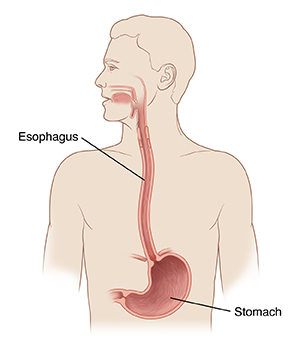Esophageal Ulcer
An esophageal ulcer is an open sore in the lining of the esophagus. The esophagus is the tube that carries food and liquid from your mouth to your stomach. This sheet tells you more about esophageal ulcers and how they're treated.

Causes of an esophageal ulcer
Esophageal ulcers can be caused by:
-
GERD (gastroesophageal reflux disease) or heartburn. This condition occurs when stomach acid flows back into the esophagus, creating irritation or discomfort. It's the most common cause of esophageal ulcers.
-
Infection of the esophagus. This is caused by certain types of fungus and bacteria. It's also caused by common viruses, such as herpes simplex virus 1 (HSV-1) or cytomegalovirus (CMV).
-
Irritants that damage the esophagus. These include cigarette smoke, alcohol, lye, acids, and some medicines.
-
Certain types of treatments done on the esophagus. These include chemotherapy and radiation.
-
Excessive vomiting.
Symptoms of an esophageal ulcer
Esophageal ulcer symptoms can include:
-
Pain when you swallow or trouble swallowing
-
Pain behind your breastbone (heartburn)
-
Feeling of food sticking in your throat or not going down right
-
Upset stomach (nausea) and vomiting
-
Vomiting blood
-
Chest pain
Diagnosing an esophageal ulcer
Your healthcare provider will ask about your symptoms and health history. They'll also give you a full exam. Tests will be done as well. These can include:
-
Upper endoscopy. This is done to see inside your esophagus. This lets your provider check for ulcers. During the test, an endoscope (scope) is used. This is a thin, flexible tube with a tiny camera and light on the end. The scope is placed into your mouth. It's then guided down the esophagus. Small brushes may be passed through the scope to loosen cells from the lining of the esophagus. Other tools may also be passed through the scope to remove tiny tissue samples (biopsy). These samples are then sent to a lab to be looked at and for diagnosis.
-
Barium swallow. This is done to take X-rays of your esophagus. This helps your provider check for ulcers. For this test, you’ll drink a chalky liquid that contains a substance called barium. The barium coats your esophagus so that it'll show up clearly on X-rays.
-
Blood tests. These check for infection, such as HSV-1, H. Pylori, and CMV in the esophagus. For a blood test, a small sample of your blood is taken and sent to a lab.
Treating an esophageal ulcer
Treatment focuses on giving the ulcer time to heal, easing symptoms, and preventing further damage. Treatment may include:
-
Medicines to reduce the amount of acid your stomach makes
-
Medicines to treat infection
-
Quitting smoking and not drinking alcohol
-
Not taking irritating medicines, such as aspirin, ibuprofen, potassium, tetracyclines, doxycycline, quinidine, iron, and alendronate
Recovery and follow-up
With treatment, an esophageal ulcer takes a few weeks or longer to heal. A follow-up endoscopy may be done to check the ulcer’s healing. Let your provider know if your symptoms don't get better or if they come back again. If you have GERD, work with your provider to manage it. You can take steps to help keep your esophagus healthy and prevent future problems.
When to call your healthcare provider
Call your provider right away if you have any of these:
-
Fever of 100.4° F ( 38°C) or higher, or as advised by your provider
-
Chills
-
Pain continues or gets worse, or you have trouble swallowing
-
Coughing up blood
-
Frequent nausea or vomiting that looks like bloody coffee grounds
-
Dark, tarry, or bloody stools
Online Medical Reviewer:
Marianne Fraser MSN RN
Online Medical Reviewer:
Melinda Murray Ratini DO
Online Medical Reviewer:
Robyn Zercher FNP
Date Last Reviewed:
3/1/2024
© 2000-2024 The StayWell Company, LLC. All rights reserved. This information is not intended as a substitute for professional medical care. Always follow your healthcare professional's instructions.